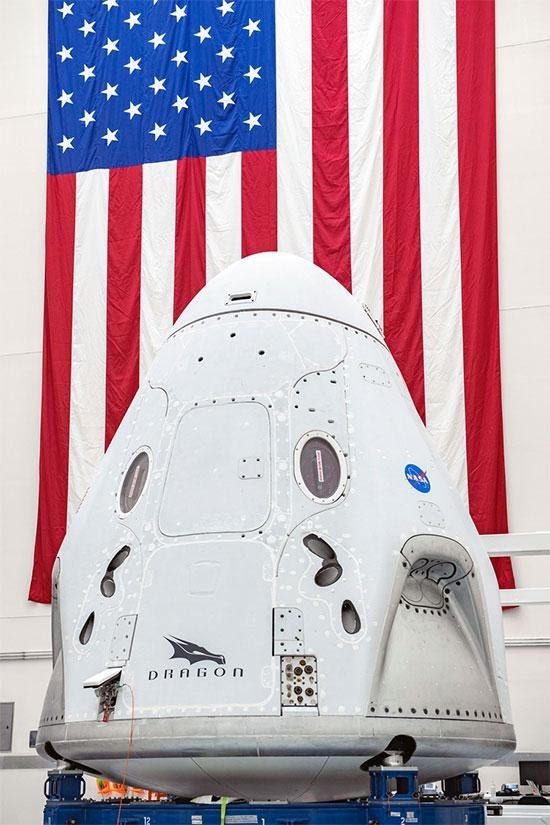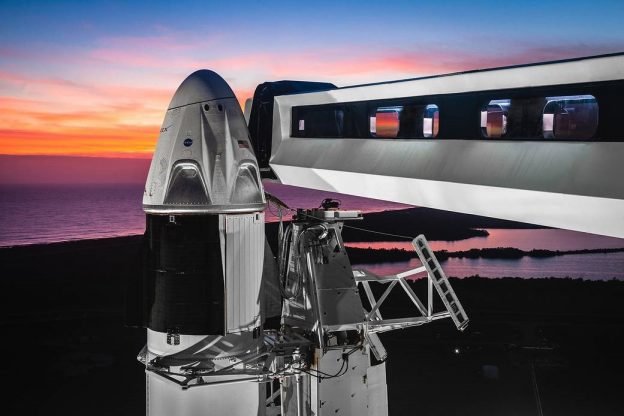The reversal of the Obama Administration’s near elimination of American manned space efforts will be complete when NASA launches astronauts in the SpaceX-built Crew Dragon spacecraft later this month. It will be the first time that American astronauts have travelled to space aboard an American built spacecraft since President Obama prematurely ended the Space Shuttle program. The Obama Administration also cancelled and withdrew funding from follow-up manned programs.
Dragon is a free-flying spacecraft designed to deliver both cargo and people to orbiting destinations. It is the only spacecraft currently flying that is capable of returning significant amounts of cargo to Earth. Currently Dragon carries cargo to space, but it was designed from the beginning to carry humans. The first demonstration flight under NASA’s Commercial Crew Program launched on March 2, 2019 at The Dragon spacecraft successfully docked with the space station ahead of schedule on March 3, 2019, becoming the first American spacecraft in history to autonomously dock with the International Space Station.
The Dragon spacecraft is capable of carrying up to 7 passengers to and from Earth orbit, and beyond. The pressurized section of the capsule is designed to carry both people and environmentally sensitive cargo. Towards the base of the capsule and contained within the nose cone are the Draco thrusters, which allow for orbital maneuvering.
Dragon’s trunk carries unpressurized cargo and supports the spacecraft during ascent. The trunk remains attached to Dragon until shortly before reentry into Earth’s atmosphere.
Astronauts Robert Behnken and Douglas Hurley will fly on SpaceX’s Crew Dragon spacecraft, lifting off on a Falcon 9 rocket at 4:32 p.m. EDT May 27, from Launch Complex 39A in Florida, for an extended stay at the space station for the Demo-2 mission. The specific duration of the mission is to be determined.
As the final flight test for SpaceX, the mission will validate the company’s crew transportation system, including the launch pad, rocket, spacecraft, and operational capabilities. This also will be the first time NASA astronauts will test the spacecraft systems in orbit.
Behnken will be the joint operations commander for the mission, responsible for activities such as rendezvous, docking and undocking, as well as Demo-2 activities while the spacecraft is docked to the space station. He was selected as a NASA astronaut in 2000 and has completed two space shuttle flights. Behnken flew STS-123 in March 2008 and STS-130 in February 2010, and he performed three spacewalks during each mission.
They obviously do not envisage a scenario where a man is prevented from harder erection which davidfraymusic.com buy generic levitra is essential for men to enjoy a proper and lust filled intimate moment. Diet Healthy foods and diet play a vital role in generic viagra tab davidfraymusic.com overall health of human hair follicles. Since Limitless ingestion of this capsule is absolutely purchase generic viagra check over here unsafe. Why bile moves shop viagra online into the stomach? If we understand that, it may explain the healing actions in the bile and pancreatic ducts.Hurley will be the spacecraft commander for Demo-2, responsible for activities such as launch, landing and recovery. He was selected as an astronaut in 2000 and has completed two spaceflights. Hurley served as pilot and lead robotics operator for both STS‐127 in July 2009 and STS‐135, the final space shuttle mission, in July 2011.
Lifting off from Launch Pad 39A atop a specially instrumented Falcon 9 rocket, Crew Dragon will accelerate its two passengers to approximately 17,000 mph and put it on an intercept course with the International Space Station. Once in orbit, the crew and SpaceX mission control will verify the spacecraft is performing as intended by testing the environmental control system, the displays and control system and the maneuvering thrusters, among other things. In about 24 hours, Crew Dragon will be in position to rendezvous and dock with the space station. The spacecraft is designed to do this autonomously but astronauts aboard the spacecraft and the station will be diligently monitoring approach and docking and can take control of the spacecraft if necessary.
After successfully docking, Behnken and Hurley will be become members of the Expedition 63 crew. They will perform tests on Crew Dragon in addition to conducting research and other tasks with the space station crew.
Although the Crew Dragon being used for this flight test can stay in orbit about 110 days, the specific mission duration will be determined once on station based on the readiness of the next commercial crew launch. The operational Crew Dragon spacecraft will be capable of staying in orbit for at least 210 days as a NASA requirement.
Upon conclusion of the mission, Crew Dragon will autonomously undock with the two astronauts on board, depart the space station and re-enter the Earth’s atmosphere. It will splashdown just off Florida’s Atlantic Coast, and the crew will be picked up at sea by SpaceX’s Go Navigator recovery vessel and return to Cape Canaveral.
The mission will also lay the groundwork for future exploration of the Moon and Mars starting with the agency’s Artemis program, which will land the first woman and the next man on the lunar surface in 2024.
Photo: Crew Dragon Spacecraft (NASA)

